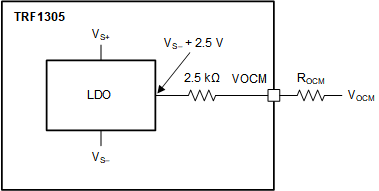JAJSKD0 December 2023 TRF1305B2
PRODUCTION DATA
- 1
- 1 特長
- 2 アプリケーション
- 3 概要
- 4 Device Comparison
- 5 Pin Configuration and Functions
- 6 Specifications
- 7 Detailed Description
- 8 Application and Implementation
- 9 Device and Documentation Support
- 10Revision History
- 11Mechanical, Packaging, and Orderable Information
7.3.2 Output Common-Mode Control
Figure 7-1 shows a functional diagram of the output common-mode control. Internally the VOCM pin sees an LDO output voltage that is equal to VS– + 2.5 V connected through a 2.5‑kΩ resistor.
Floating the VOCM pin is allowed. The output common-mode voltage at the output pins, OUTPx and OUTMx, defaults to the LDO output voltage of VS– + 2.5 V when VOCM pin is floated. Floating the VOCM pin results in a VOCM voltage equal to midsupply when VS = 5 V. If the VOCM pin is driven, then drive the pin from a low-impedance source. Limit the value of ROCM to less than 25 Ω for accurate reflection of the forced VOCM voltage at the device outputs.
 Figure 7-1 Output Common-Mode
Control
Figure 7-1 Output Common-Mode
Control